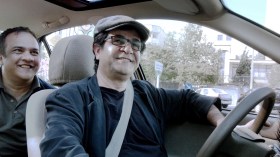Nostalgia, that is, a yearning for the past, has its roots in the Greek word for homesickness (literally nostos ‘return home’ + algos ‘pain’). Long before Disney and Netflix were capitalising on this to sell new series and their tie-in products, ‘nostalgia’ affected many people, and was classified as an acute psychological condition.
In Mario Martone’s film Nostalgia, businessman Felice is gradually coming down with something akin to that condition – which was first described in medical literature as ‘the pain which the sick person feels because he is not in his native land, or fears never to see it again’.
After 40 years of absence, Felice has returned to his hometown of Naples. While there he has discovered that the places of his youth have remained much the same – but it is the code of the city itself, and his past friendships, that have changed so much that it discombobulates him.
Based on a 2016 novel of the same name by Ermanno Rea, Mario Martone co-wrote and directed the film in Italian and French. It premiered at the 75th Cannes Film Festival in May 2022, in the official competition for Palme d’Or. Pierfrancesco Favino (World War Z, Angels and Demons) stars as Felice.
Coming home
The first act feature some of the finest acting ever put to screen, as Felice returns home to Naples to help his mother, Teresa, get around in her old age. Favino and Aurora Quattrochi deftly balance the joy of a mother and son reunion with the deep aching sadness of a parental figure lose their will to live. The scene where Felice carries Teresa to the bathtub and gently washes her will surely bring a tear to anyone’s eye. These slow, tender moments capture the emotional high point of the film, and my only qualm is that it happens so early and fades out all too soon.
While looking through his mother’s things, Felice finds an old photograph of himself and an unidentified boy on a motorbike. He tucks it away, leaving it unaddressed, but like any good ‘Chekov’s Gun’ motif this photograph is loaded with significance and ready to blow at any moment.
This photograph triggers Felice’s memories of his boisterous youth and his friendship with a young man named Oreste. Through his rose-tinted glasses we are transported back to that time, where a change in aspect ratio and film colouring work to trigger the audience’s own feelings of nostalgia for the 70s. Since he is already in town, Felice decides to seek out his old friend.
A priest, a photograph, and a gang
But first, he must seek the advice and approval of local Catholic priest Don Luigi. This is one of the film’s most ironic relationships, since Felice has just spent 40 years in Cairo, converted to Islam, and married an Egyptian woman.
Luigi, brushing aside Felice’s leaving of the church, tells him that his childhood friend Oreste has become a very different person since he left town. In fact, he has become a dangerous boss of the Camorra, the local organised crime syndicate.
Felice is taken aback by this news, but ignores Luigi’s warnings and proceeds to meet with Oreste. From this point in, the film meanders. We understand the central theme of the text, and we can see where it is all heading, so I found myself begging for the film to get to the end already.
Nostalgia‘s one hour and 57 minute run-time sadly felt much, much longer in the cinema where I viewed it, and that’s not counting the many ads I saw for the Italian Film Festival (where this film is headlining) that preceded the feature. Once the narrative twist is telegraphed, it is hard to stay absorbed in this slow-burner, even despite its sumptuous visuals and outstanding performances.
The jazz-filled score and 70s rock ‘n’ roll needle drops round out what is, in the end, a really well crafted film. As a whole, it evokes Scorsese on an off-day, which is still better than a lot of cinema offered today.
Nostalgia will be shown on various dates around Australia from 14 September, as part of the St. Ali Italian Film Festival.
Actors:
Director:
Format: Movie
Country:
Release:





